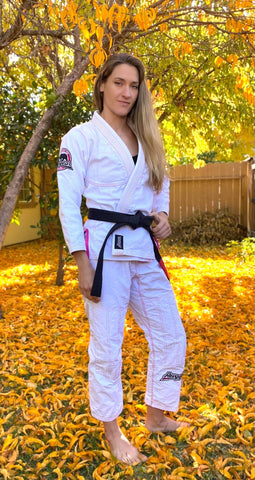When it comes to Brazilian Jiu-Jitsu (BJJ), the uniform known as the gi plays a vital role in both comfort and performance.
Whether you're a beginner or an experienced practitioner, understanding how a BJJ gi should fit is essential.
We will provide you with a comprehensive tutorial to get the perfect fit for your gi, addressing common FAQs and focusing on both men's and women's gi sizing.
Is a gi supposed to be baggy?
No, a BJJ gi is not supposed to be baggy. The ideal fit of a gi is neither excessively loose nor overly tight.
The gi should provide enough room for movement while maintaining a clean and fitted appearance.
Excessively baggy gis can give opponents more material to grab, compromising your performance on the mat.
To ensure a proper fit
To ensure the Gi has the proper fit, start by selecting the appropriate size based on your height and weight. Consult the manufacturer's size chart for guidance.
When trying on the gi, pay attention to the jacket and pants. The jacket should have sleeves that reach the wrists when arms are extended, with enough space to grip the collar without excessive slack.
The pants should have a comfortable waistband that allows for secure fastening, with the length reaching just above the ankles to avoid tripping during training.
For example, if you are 5'10" (178 cm) tall and weigh 170 lbs (77 kg), a size A3 may be suitable. However, it's important to refer to the specific size chart of the gi brand you are purchasing.
How should a BJJ Gi fit properly?
A gi should fit snugly around your body without restricting your movement. Here are a few key points to consider for the proper fit:
Jacket:
How should a BJJ Gi fit with a jacket - the jacket should fit comfortably across the shoulders and chest, allowing you to move your arms freely.
The sleeves should reach the wrists when your arms are extended, but they should not be overly long or baggy.
The gi should have enough room in the body to prevent constriction while still maintaining a clean and fitted appearance.
Pants:
The waistband should fit securely and comfortably around your waist, ensuring that the pants stay in place during training.
The length of the pants should reach just above the ankles, allowing for ease of movement without the risk of tripping.
How should a women's gi fit?
The fit of a women's gi is similar to that of a men's gi, with a few additional considerations:

Jacket:
Look for a gi that is designed to accommodate a female physique, such as tapered sleeves and a slightly more fitted waistline.
Ensure that the jacket provides enough room in the bust area without being too loose or tight.
Pants:
Some women's gis have a higher waistline to provide a better fit.
Consider the differences in hip-to-waist ratio and choose a gi that caters to your specific body shape.
It's important to try on different brands and sizes to find the best fit for your body type.
How do you size yourself for a gi?
Sizing yourself for a gi involves taking accurate measurements to ensure the best fit. Follow these steps:
Measure your height: Stand barefoot against a wall, ensuring your back is straight and your heels are touching the baseboard. Use a tape measure to measure from the top of your head to the floor.
Measure your weight: Weigh yourself on a scale in your training attire.
Consult the size chart: Each brand may have its own size chart, so consult the manufacturer's guidelines to find the appropriate size based on your height and weight.
For example, if you are 5'7" (170 cm) tall and weigh 150 lbs (68 kg), a size A2 may be suitable for you. However, always refer to the specific size chart provided by the gi manufacturer.
How and where to place the belt?
When asking "how should a BJJ Gi fit?" you should consider the following. The belt is an important part of the BJJ gi and signifies a practitioner's rank. Here's how to tie and position your belt properly:
Hold the belt with the logo facing outward, in the center of your abdomen.
Wrap the belt around your waist, crossing it at the back.
Bring both ends of the belt forward and cross them over each other.
Wrap the ends around your waist again, crossing them at the back.
Bring the ends back to the front and tie a square knot.
The knot should be tied firmly but not too tight, allowing for easy adjustment during training.
The belt should be centered around your waist, with the ends hanging down evenly on both sides.
Finding the right fit for your BJJ gi is crucial for both comfort and optimal performance on the mat.
By understanding the key guidelines for fit, consulting size charts, and trying on different brands and sizes, you can ensure that your BJJ gi fits perfectly and enhances your overall training experience.
Additionally, don't forget to tie and position your belt correctly to maintain the traditional and respectful aspects of BJJ.

































